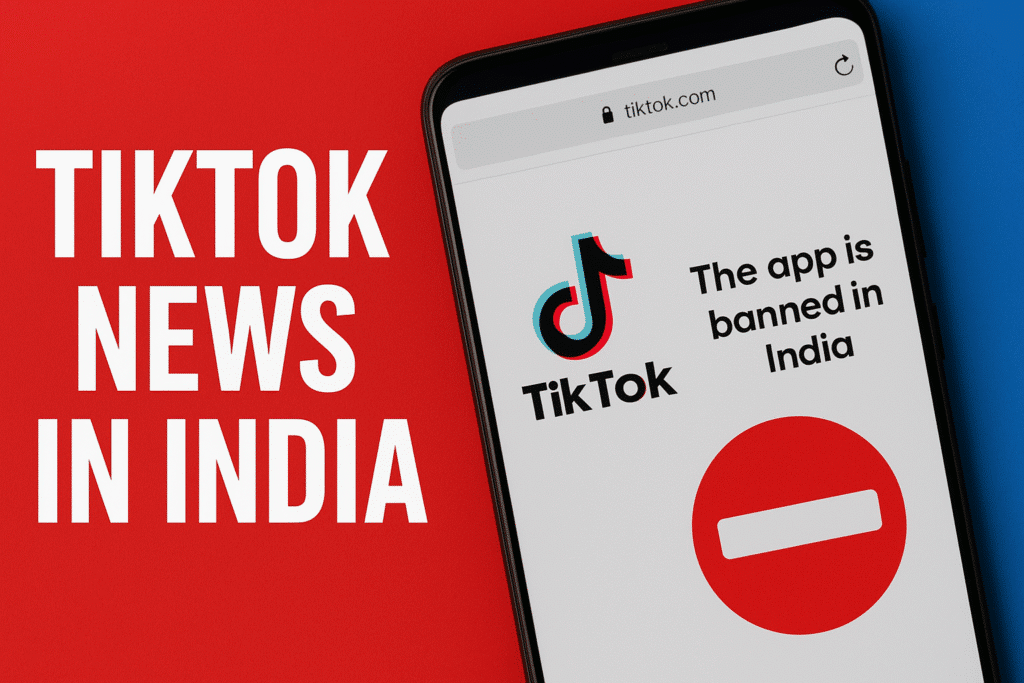Introduction
TikTok news in India has once again ignited headlines as the platform’s website suddenly became accessible for numerous users. However, officials have clarified that the ban imposed in 2020 remains intact, putting to rest speculation about its comeback. The development highlights how quickly misinformation spreads online, especially when it involves one of the world’s most popular apps.
Key Points
- Users in India briefly reported access to TikTok’s website this week, sparking speculation of a comeback.
- The Indian government confirmed that no order has been issued to lift the ban.
- TikTok clarified that limited access was the result of a technical misconfiguration, not a policy change.
- The 2020 ban, enforced over national security and data concerns, remains in place.
- Social media reacted with humor and memes, showing continued public curiosity about the app.
Unexpected Access, But No Comeback Yet
Reports began circulating in late August 2025 that TikTok’s website was suddenly accessible to users across different regions of India. Screenshots of the homepage began trending online, with many users assuming the app had been quietly restored. The buzz quickly escalated into speculation that TikTok was preparing for an official return to the Indian market.
However, The Ministry of Electronics and IT clarified that the restrictions on TikTok and similar Chinese apps are still active, labeling the claims of an official unban as “false and misleading confirmed that the restrictions imposed in 2020 remain legally valid and continue to be enforced by service providers.
TikTok itself also issued a clarification, stating that the brief visibility of its landing page was the result of a network-level misconfiguration and not an indication of its re-entry into India. The company emphasized its continued compliance with Indian regulations, underscoring that there has been no official clearance to resume services.
Limited Website Functionality
While users were able to access parts of TikTok’s homepage, the functionality was largely restricted. No videos could be watched, no accounts could be logged into, and no uploads were possible. Essentially, only the landing page and static sections of the website appeared to load, offering no real user experience. This limited access confirmed that TikTok was still under an active block, with full services unavailable.
For curious users, the brief accessibility may have been misleading, but experts note that such partial visibility often occurs due to technical changes at the server or provider level. It does not imply regulatory approval or a reversal of government orders.
Why the Ban Still Stands
TikTok was among 59 Chinese apps banned in India in June 2020, following escalating tensions between India and China. The government cited risks related to sovereignty, national security, and the misuse of personal data as reasons for the blanket ban. At the time, TikTok had nearly 200 million active users in India, making it one of its largest global markets.
Since then, the ban has been reinforced multiple times, with the government making it clear that the decision was not temporary. By early 2021, the ban was formalized as a permanent directive. Despite occasional rumors and speculation, no serious move has been made to reverse the policy.
Even today, the underlying reasons remain unchanged. Concerns around user privacy, cross-border data flows, and cybersecurity threats continue to shape India’s digital policy. Officials argue that lifting the ban without structural safeguards would undermine the government’s stance on digital sovereignty.
Public Reaction and Memes
Social platforms buzzed with responses as rumors of TikTok’s return spread. Hashtags trended on X (formerly Twitter) and Instagram, with many users jokingly preparing for the “return of lip-sync videos” and the revival of creators who built careers on TikTok before the ban. Memes circulated comparing the moment to a surprise festival, while others mocked the excitement by pointing out that no actual features were functional.
This reaction highlights the lingering influence TikTok has on India’s digital culture. Even after five years of absence, its popularity remains evident through the memes, nostalgia, and ongoing discussions every time a rumor surfaces.
The Larger Context
TikTok’s situation in India is a reminder of how geopolitics intersects with technology. While the app continues to operate successfully in other global markets, India’s stance reflects a broader strategy of controlling data flows and protecting national interests. The episode also illustrates how misinformation can spread rapidly when technical glitches create misleading impressions.
Conclusion
In the latest TikTok news in India, the sudden accessibility of its website created widespread speculation, but both the government and TikTok have confirmed that the ban remains firmly in place. With national security and data protection at the core of India’s digital policy, any official return of TikTok still appears unlikely in the immediate future.





